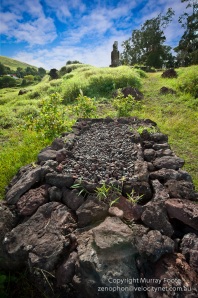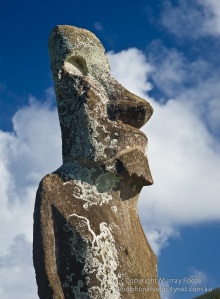Ahu Huri a Urenga is just out the back of town, beside the main road to the other end of the island. Restored by Mulloy in 1960, it is 13 metres long by 4 metres wide and has been dated to 1215 AD plus or minus 90 years. The single moai is 3.3 metres tall by 1.45 metres wide and appears to have been recarved because it has four hands rather than two.

Ahu Huri A Urenga. Click on the image to see the extra pair of hands at the right. (The ones at the left are obscured underneath the fungal growth).
Behind the ahu is a cremation platform (as shown at right). This funereal method became impractical when all the wood was gone.
Many ahus were astronomically aligned and this one is a case in point. The moai faces the winter solstice sunrise and the ahu has many cupules with solstice and equinox alignments.
There has been some debate as to whether pukeo (topknots) were placed on top of the moai after the moai were erected, or whether the moai and the pukao were strapped together on a frame and raised as one unit. An unfinished pukao was found at this ahu, which suggests that the pukao were placed on top after the moai were raised.
Speculation: Did the Spanish get to Easter Island in the sixteenth century?
About twenty years ago, I attended a talk by Canberra author Robert Langdon who suggested that Spanish people made it to Easter island in the early sixteenth century. He had written several books, travelled to key places and read original documents in sixteenth century Spanish.
His trail started when he read of the discovery in the 1970s of old Spanish cannons on a reef on an island in the Tuamoto Archipelago.
Following the return of Magellan from his trip around the world, Spain sent another similar expedition that left in 1525 with seven ships under the command of García Jofre de Loaísa.
They had considerable difficulty getting through the Straits of Magellan to the Pacific. One ship turned around and returned to Spain and two others sunk though their crews were rescued. Four ships made it through to the Pacific but one, the San Lesmes separated from the rest in a storm and was never heard of again.
It seems that after sailing for weeks or months, the San Lesmes ran aground on a reef at Amanu in the Tuamotos. Getting off the reef required making the ship lighter so they tossed some cannon overboard, just as Cook did on the Great Barrier Reef in Australia on 11 June 1770, some two hundred and forty-four years later.
The cannon recovered from the Amanu reef were later dated to around the 1520s. It is overwhelmingly probable that they were from the San Lesmes because very few Spanish expeditions traversed the Pacific during the sixteenth century. This is largely because almost all such expeditions were expensive disasters, yielding little and with very few survivors making it back to Spain.
Langdon claims the ship then went to another island to refit, the crew picked up Polynesian wives and family, and they eventually dispersed to the Society Islands, Easter Island and New Zealand.
When Roggeveen landed on Easter Island in 1722, he made some observations which some might interpret as showing European ancestry.
As for their complexion they are brownish, about the hue of a Spaniard, yet one finds among them some of a darker shade and others quite white, and no less also a few of a reddish tint as if somewhat severely tanned by the sun.
One amongst these (who came on board) was an entirely white man who was wearing chocks of wood in his ears as large as one’s fist and bore a very devout appearance, so we took him to be an idol priest.
… these islanders being in colour between white, swarthy, and reddish, not thick lipped nor flat nosed, the hair chestnut coloured and limp, some have it black, and others tending to a red or cinnamon tint. … their appearance being thoroughly pleasing and tallying with Europeans more than with Indians.
Conversely, Cook saw Polynesians only, generally with black hair.
If the Spanish had made it to Easter Island in the sixteenth century, they wouldn’t have affected the Classic Culture because it was already in decline and seriously short of resources, though they might have contributed to the descent into warfare.
Katherine Routledge who was in Easter Island in 1914-15, took back to Europe two skulls that she claimed were of quite different types.
However, the Rapanui were particularly enamoured with light coloured skin. A cave on the Poike Peninsula, Ana O Keke (actually a lava tube and also called Cave of the White Virgin) was said to be used to sequester young women for several months so their skin became very pale and they thereby became specially attractive. Favoured children might be kept in hare paenga (the boat-shaped houses with no windows) for the same reason.
Similarly, in the Bird Man era, the tangata manu (the Bird Man or Head Chief for a year) was tapu, secluded in a special house and not to be touched. Something similar may also have applied to the ivi atua (priests) in the classical era, in which case their skin would have been pale for this reason.
It’s an intriguing little loose end to conjure with. However, it simply may be that Roggeveen’s observations partly reflect the natural variation of Polynesians and partly the workings of Rapanui culture. Certainly there is no current scientific support that the population of Easter Island was anything than Polynesians.
Some Links to Other Travellers’ Blogs
About five months before this trip, I met David and Denise Hooper at Batman’s Bay Blues Festival, where I was photographer. David was wearing a Patagonia tee-shirt, I was heading to Patagonia and we got talking. David gave me valuable information about El Chalten (in Argentina) and Torres Del Paine National Park (in Chile) and the logistics of travelling around by hire car. This changed and improved our trip.
Earlier, this year, David and Denise went on their own remarkable adventure, to Mali and Ethiopia. You can see David’s photos and comments in his blog. Also, you can see a Mali slideshow with an African soundtrack. Lastly David and Denise remarried in a Tuareg wedding.

View from Maunga Orito, near Ahu Huri Urenga. The slopes of Rano Kau, leading up to Orongo, are at far left. Then there is the runway where we were due to fly out later that day. Directly in front and stretching out to the right is Hanga Roa.
Also, for several days on Easter Island we kept running into someone else with “serious” camera equipment. They turned out to be an English couple, Michael and Lisa Parker. You can see photos and comments of his travels in South America and Easter Island in his blog. This includes some images from inside the Easter Island museum, where I didn’t take photographs, and also some from the Atacama desert, where we didn’t go.




Pingback: Easter Island Wrapup and Contents | Murray Foote
You have more useful info than the Britsih had colonies pre-WWII.
LikeLike
Thanks very much .
LikeLike
Pingback: Itinerary of Journey to Patagonia, Antarctica and Easter Island | Murray Foote